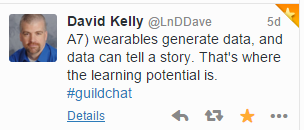e-learning for social programs and community initiatives
There are a lot of causes or issues in the world and we often see...
Read MoreThis is part 3 of my series exploring wearables in training and development. In part 1 I talked about the angle that I’m most interested in: wearables providing a trigger, feedback and data for learning and performance. In part 2, I explored it a bit further, making connections to self-reporting components, affective aspects and behaviour change.
In the next few posts, I’ll look at how wearables could play a role in different types of training situations, beginning with manufacturing organizations. I’m curious about this segment, as the majority of applications that are shown for wearables are typically busy professionals who need a watch because they can’t even take the time to look at their phone, but here’s a lot of different types of work out there, and yet the emphasis is often on the knowledge worker. There are things about manufacturing work that sets it apart from knowledge work.
In manufacturing organizations, there are significant pressures to maximize efficiency (in reality, the role of humans in manufacturing operations is on the decline as more of these repetitive actions are done by robots), so there is likely a role that wearables could play to ensure this time to competency is reduced. Let’s assume that the employee is keen to reduce this time to competency and is not being pushed by a demanding employer, there are many things that could be an aid to monitoring and supporting learning. Let’s face it, having a laptop or even a tablet or handheld phone on a production floor is unwieldy and unlikely, so wearables could fit this niche.
If the employee wants to use a wearable (such as Google Glass or head mounted camera) to record portions of their work to play back and spot potential for improvement, they could use that approach to capture and review. They could “work out loud” narrating what they are doing, what they have questions about, what things they find challenging, etc. This could be reviewed by the employee and a smart system could provide short bursts of instruction after playback. Or it could be transmitted to the supervisor or expert for coaching.
There could be RFID chips or n
Smart watches or arm bands could also provide a visual cue in a potentially noisy environment. A vibration might alert you to look at the screen giving you a message to adjust your actions, access a piece of performance support or capture that moment in time for data collection.
Wearables could offer a training “mode” in manufacturing environments, where feedback is provided during real work (not simulation) that gives coaching and corrective input to ensure that the employee is learning IN the work environment, with actual feedback on their real performance. This would be a real benefit for learning in situ, blending real time feedback with performance support. One organization is even pitching gloves that will shape your muscle memory.
And there is also the potential for virtual reality to provide a simulated workplace for training purposes. This is likely too costly for most manufacturing operations, however the potential exists.
What do YOU think? Have I highlighted the things that are most relevant to manufacturing? Do you have insights to share about wearables in manufacturing? Share them in the comments below! Next time we’ll look at wearables in service industries.
You might want to check out David Kelly’s blog, he’s written and collected insights about wearables as well.